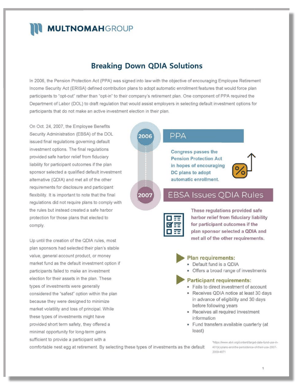Of the three most common Qualified Default Investment Alternative (QDIA) solutions, (1) balanced fund, (2) target date funds, and (3) managed accounts, which one is most appropriate for your retirement plan? Understanding the three C's of QDIA can help decipher which solution is most appropriate for your retirement plan strategy and goals.
The three C’s of QDIA
Customization
The differences in customization are apparent. In selecting a balanced fund, all defaulted participants will use the same product and, as a result, the same allocation. As you move to target date funds, all participants with a similar age share an asset allocation (think of this as having multiple balanced funds). With a managed account, age may be considered alongside additional factors such as current savings rate, accumulated assets, and the design of the plan.
In theory, as you broaden the variables for consideration, that should allow for investment solutions to become more efficient (better matched to the individual). However, there are limits to how much data a sponsor can reasonably provide, and frequently with customization comes a cost, either in the solution selected or the costs associated with monitoring it from a fiduciary perspective.
Complexity
While any investment product can be made to be complex, moving beyond a single balanced fund and to target date funds or managed accounts adds complexity. In the case of target date funds, you have extended from a single fund to an array of products based on a participant’s age, and each participant has a unique asset allocation.
While target date funds and models have discernable fee and performance information, benchmarking the funds to an appropriate index or even peers require significantly more expertise as products aimed at participants at the same age will have significantly different asset allocations dictating performance. The complexity of assessing managed accounts as a QDIA is further complicated as the solution set may include dozens of different portfolios, usually constructed from the plan’s underlying investment options. These model returns are rarely calculated, and as a result, the fiduciary is left to conduct sample testing of the model and determine whether model portfolio outputs are reasonable given the provided inputs.
Cost
As with any asset strategy, cost and performance net of cost is what you seek. Whether through a single balanced fund or a series of target date funds, the cost of investment management is an important input to the decision-making process. When adding the complexity and customization of a managed account as a potential QDIA, costs frequently increase.
While not always true, in the overwhelming majority of cases, managed account services add additional costs above the costs of the investment products that make up the asset allocation. These additional costs create a hurdle for sponsors and fiduciaries. Will this solution, net of fees, generate materially better portfolios for participants than other lower cost alternatives? In some cases, the cost / value equation may include any additional costs relative to monitoring a managed account QDIA solution.
While this cost consideration is material now, the future may look different. With the rapid growth of robo-advisor solutions in the broader financial services marketplace, managed account utilization is increasing, and costs appear to be declining. The future may be one where managed accounts have a very low or even no direct cost for utilization.
The DOL doesn’t mandate which types of plans should use which types of solutions. However, there are some best-practice considerations to make when determining which QDIA structure may work best for your plan. Target date funds have become the default of defaults, meaning the most frequently used solution for plan sponsors. It falls in a sweet spot of complexity / customization / cost.
For a review of the history of QDIA, the regulations around QDIA, the types of QDIA, and understanding which QDIA solution may work best for your retirement plan, read our short guide.

Multnomah Group is a registered investment adviser, registered with the Securities and Exchange Commission. Any information contained herein or on Multnomah Group’s website is provided for educational purposes only and does not intend to make an offer or solicitation for the sale or purchase of any specific securities, investments, or investment strategies. Investments involve risk and, unless otherwise stated, are not guaranteed. Multnomah Group does not provide legal or tax advice.


